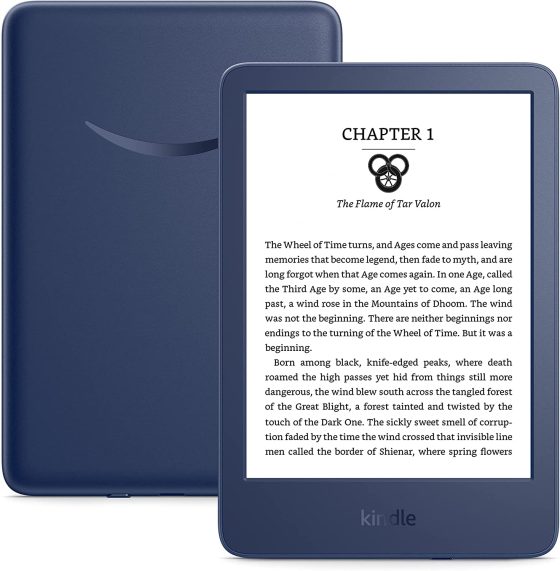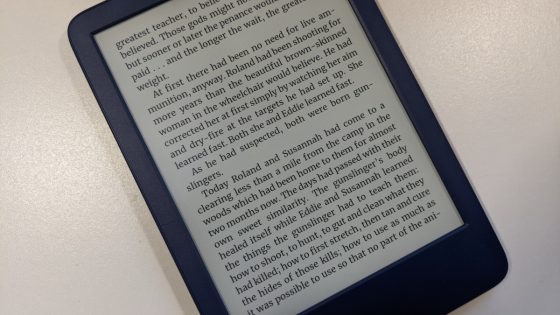Review Date: October 2022 – Review unit purchased from Amazon
Overview
The 11th generation Kindle was released on October 12th, 2022. It has a 6-inch E Ink screen with a frontlight, and it’s the basic entry-level model in the Kindle line.
It’s the first “Kindle” to feature a 300 ppi E Ink screen, with all previous Kindles having 167 ppi screens, dating all the way back to the 1st gen model from 2007. Previously the higher resolution screens were only available on the upgraded models like the Kindle Paperwhite and Kindle Oasis.
Other changes with this model include the switch to a USB-C port, they added support for dual band WiFi, and Amazon bumped storage space up to 16GB. It also has a new design that’s lighter and smaller than the previous generation model.
The Kindle still lacks the warm frontlight option that comes on the higher up Kindles, and it’s not waterproof like the Paperwhite and Oasis, but it offers all the same general reading features at a lower price.
The 11th gen Kindle is available in a new blue color that Amazon calls denim, and it also available in black. The ad-supported version sells for $99 and the ad-free version is $119. There’s also a kids bundle that comes with a cover, an upgraded 2-year warranty, and a 1-year subscription to Amazon Kids+ for $119.
Quick Review
Pros
- Highly-portable; very small and lightweight.
- The 300 ppi screen is a big upgrade from the previous model.
- Cheap.
Cons
- Basic design with cheap plastic that scratches easily.
- Frontlight not quite as nice as the Paperwhite’s, with no warm light setting.
Verdict
The 11th gen Kindle is a solid upgrade over the previous model and I really like how small and portable it is, especially now that the Paperwhite is larger and less pocketable with the 6.8-inch screen.
I’m not a big fan of the cheap plastic that scratches easily, but other than that it’s hard to find much to complain about. It’s nice to finally to have a 300 ppi screen on the basic Kindle. This is the first entry-level model that Amazon has released in a long time that I actually like using—167 ppi was just too low on the older models after getting used to 300 ppi.
Kindle Video Review
Kindle vs Kindle Paperwhite Comparison »
The Design
At 158 grams (actually my scale says 154 grams), some might be tempted to call the new Kindle the lightest Kindle ever, but the 1st generation Kindle Oasis was lighter without the charging cover at only 131 grams, so this one is in fact the second lightest Kindle.
But it is the smallest and most pocketable Kindle ever, with narrower bezels and a smaller overall size than ever before. I really like the portability aspect of the design. The Kindle easily fits in a pocket thanks to the small size.
I thought I would have problems accidently activating the touchscreen with the side bezels being so narrow, but because the screen is recessed I haven’t had a problem with it, but I tend to hold the device from the bottom more than the sides anyway.
Some people don’t like the placement of the power button on the lower edge of Kindles, and that hasn’t changed with this design, but the Kindle is now so light that I find it actually quite difficult to accidently press the power button. You can prop the Kindle up with the power button resting on a table or your hand and the Kindle isn’t heavy enough to activate it.
My one gripe with the design is the plastic casing feels cheap and scratches easily, but they’re making Kindles out of recycled plastic now so I guess that counts for something.
Older Kindles were made out of plastic too, but thinking back on the Kindle 4 and 5 from ten years ago their designs were definitely more refined and classy than they are now. The plastic didn’t feel like cheap plastic; the finish had a nicer feel, and it didn’t scratch as easily.
Hardware
Like the Kindle Paperwhite 5, the new Kindle is faster and more responsive than before. Turning pages, opening menus, navigating the user interface—everything is faster.
Amazon also switched it over to a USB-C port like the Paperwhite, and that helps make charging times faster as well. The Kindle supports dual band WiFi now too.
They also doubled the storage space to 16GB, which is actually more than the base Paperwhite comes with (but they did add a 16GB version of the Paperwhite as well for an extra $10).
Amazon claims the battery on the new Kindle can last for up to 6 weeks, compared to 4 weeks on the previous model. That’s not as good as the Paperwhite at 10 weeks but it’s a worthwhile improvement nonetheless.
The biggest hardware change is of course the screen…
The Screen
This is the first “Kindle” to have a 300 ppi screen; all the previous versions only had 167 ppi. Now it’s in the same category as the more expensive Paperwhite and Oasis models, and text definitely looks sharper and clearer with the new screen.
One difference with the Kindle compared to the other 300 ppi Kindles is the fact that it has an indented screen instead of a flush screen. It’s like the Paperwhite 3 in that regard, and I think it uses the same screen, but with a much smaller overall design (the Paperwhite 3 has massive bezels).
I like the indented screen because the text looks clearer without the added flush layer over the top, and fingerprints and glare are less noticeable as well.
For some reason the Kindle Voyage’s screen is still clearer and the text is darker, but the new Kindle isn’t far behind.
The frontlight is very evenly-lit as well. Something about the color isn’t quite as natural as the Paperwhite, and it doesn’t have the warm frontlight, but it gets the job done.
Software Changes
In terms of software, nothing has really changed with this new Kindle. It runs the same software as other current Kindles, with the new user interface that Amazon started rolling out last year.
The one difference is the Kindle now supports Dark Mode for white text on a black background. The previous entry-level model did not support Dark Mode.
More Kindle Reviews
Kindle Specs
- 6-inch E Ink display with 300 ppi.
- Adjustable frontlight with 4 LEDs.
- 2-point capacitive touchscreen.
- 16GB internal storage.
- USB-C port.
- Supports 2.4 GHz and 5.0 GHz WiFi.
- Bluetooth for streaming audiobooks and VoiceView.
- Battery life: Up to 6 weeks
- Supported formats: Kindle Format 8 (AZW3), AZW, KFX, TXT, PDF, MOBI, PRC; and EPUB, HTML, DOC, DOCX, JPEG, GIF, PNG, BMP through conversion; Audible AAX audio format.
- Weight: 5.56 oz, 158 grams.
- Dimensions: 6.2″ x 4.3″ x .32″ (157.8 x 108.6 x 8.0 mm).
- Price: $99-$119 at Amazon.



“My one gripe with the design is the plastic casing feels cheap and scratches easily, but they’re making Kindles out of recycled plastic now so I guess that counts for something.”
So, like my Kobo Libra 2, which somehow picked up a scratch whist being in the official sleep cover?
Can’t go from 6.8 back to 6, especially since my hands are big enough I can still grip the Paperwhite 6.8 around the back in one hand and turn pages, but I find how light and small this is super impressive. I also think I read or saw somewhere (maybe even here) that perceived contrast is better on indented screens. Haven’t seen it in person so can’t really evaluate the plastic issue you mentioned without holding it myself, but a case can definitely be made that this is the best kindle for the average person.
Like so many others that ordered this smaller. cheaper version cannot connect to WIFI.
Tried just about every solution out there. Ready to send it back. Maybe my kindle from 2015 wasn’t so bad after all.
Was really looking forward to smaller light weight version.
This was a helpful review, thank you!